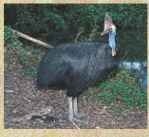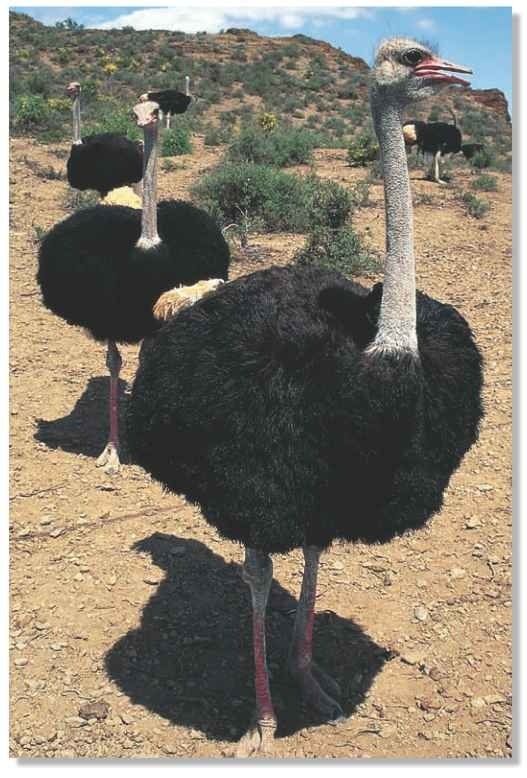ORDER
Struthioniformes
FAMILY
Struthionidae
GENUS & SPECIES
KEY FEATURES
• Lives on open plains where its “watchtower” vision helps it spot
predators; its group-based lifestyle also gives the protection essential for exposed plains dwellers
• Gapes its bill and spreads its wings to dissipate body heat
• Gleans all of its
water needs from plant [ food — except during the driest months
WHERE IN THE WORLD?
In a strip across Africa f between 10° and 20° [north of the equator {.— East Africa south ; down the Rift Valley to Tanzania; also inhabits South Africa, Namibia, southern Angola and 1 Botswana
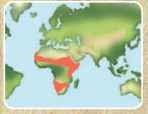
Lifecycle
The ostrich may be flightless, but it can run extremely fast — which is how this huge, nomadic bird escapes from predators as it roams the open grasslands in search of food.
HABITAT
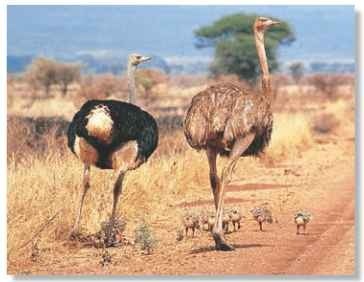
A Walk tall
The ostrich’s great height suits it to plains life.
The ostrich lives on the short-grass savannahs of Africa and in semidesert regions. It wanders far in search of food, moving to desert areas when vegetation springs up after seasonal rains.
The ostrich avoids long grass, where predators may lie in wait and shuns thick woodland for the same reason. It favors undulating land, which allows it to feed inconspicuously and where it can run away at the first sign of danger Any areas where humans have altered the landscape in any way are avoided.
CONSERVATION
Traditionally, the ostrich was hunted for meat, eggs and hide, as well as feathers. A more recent demand for its meat has prompted growth in commercial farming; this has relieved hunting pressure on wild birds, whose status is stable. Today, the ostrich has to compete with domestic grazing stock on its native grasslands, but it prospers in reserves. Attempts are being made to reestablish it in its former range.
BREEDING
The male performs a courtship dance in front of a female and prepares several nests for her. After mating, the female selects a nest and lays her first egg, which is 6″ long. As the first to be mated, she becomes the dominant female of the group. She lays an egg every two days, to a total of up to 11 eggs.
The male also mates with several other females. They all lay clutches in the same nest; there may be 20 to 30 eggs when the dominant female is ready to begin her 42- to 46-day incubation. If there are too many eggs to brood, the female rolls a few from the nest. The whole clutch may hatch in one or two days. Chicks are first guarded by both the male and female but later join other broods to form a creche, reaching full size in 18 months.
COURTING COUPLES
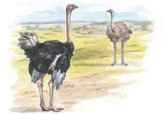
Let courtship begin…
The male approaches the female with straight neck, erect, fluffed tail and drooping wings.
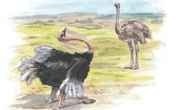
Swooning and swaying…
When close, he drops down with wings outspread. He sways his neck, while raising his wings alternately.
BEHAVIOR
The ostrich normally lives in small groups (five to ten birds), although larger flocks assemble around water in the dry season or where food is abundant.
Groups stride across the short grass plains, frequently picking food from the ground. When not feeding, the ostrich spends its time resting, dust bathing and preening.
With its excellent hearing and height, the ostrich is often the first animal on the plains to spot a predator; its fleeing flocks often alert other animals to danger.The ostrich can reach speeds of 39 mph and outpaces most enemies. Rarely, it kicks powerfully in self-defense.
All together now… Large flocks gather around water in the dry season, but spend most of their time in smaller family groups.
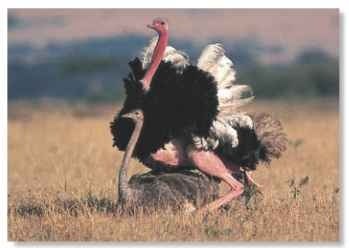
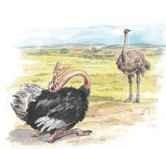
Back beat…
As the display gets frenzied, his neck writhes violently and his head thumps on his broad back.

Check mate
When the female is ready, they walk together. She lies down and the male mounts her.
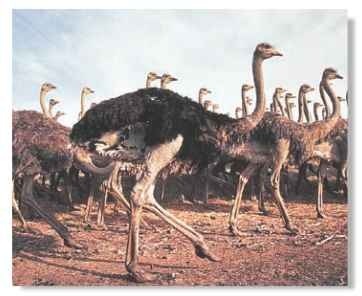
FOOD & FEEDING
The ostrich feeds in a small group, stooping for plant material (mainly herbs, grasses, seeds and flowers) and occasionally insects and small lizards. It swallows several items together, which can be seen travelling down the neck as a small lump or bolus.
In dry areas, the ostrich browses on succulent plants, which may provide all its water needs, although it will drink regularly when water is available. It also swallows small stones and grit to help break down and digest plant matter In captivity, an ostrich may swallow all manner of strange objects as substitutes for this digestive grit: one zoo bird met an untimely end after attempting to digest a 3′ length of rope.
Drink up! Ostriches are especially on guard for predators at waterholes.
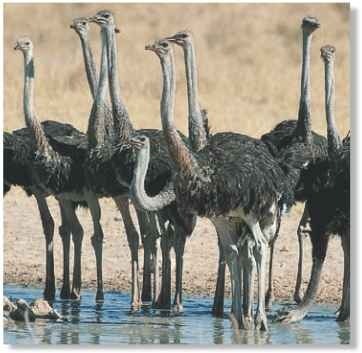
When threatened, an incubating ostrich will lay her neck and head flat on the ground. This may have given rise to the legend that a threatened ostrich buries its head in the sand.
A man weighing 250 lbs. can stand on an ostrich egg without breaking it.
Egyptian vultures have been seen cracking open ostrich eggs by dropping large stones on them.
PROFILE
Ostrich
The ostrich’s powerful legs equip it to roam the open plains with ease, while other special features help it cope with the relentless heat and dust.
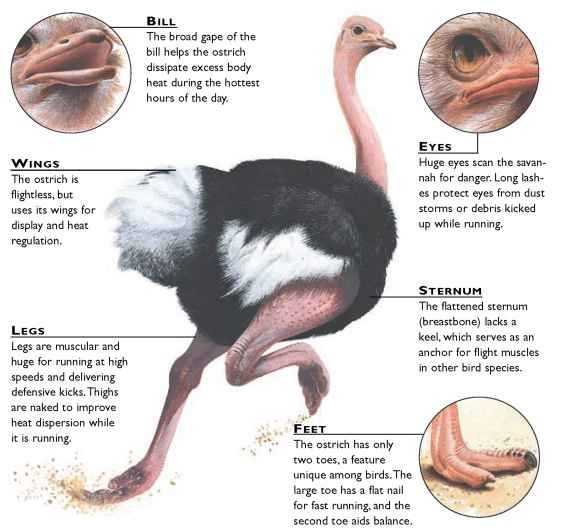
CREATURE COMPARISONS
At up to 8′ tall, the male ostrich is the largest living bird. Its flightless relative, the Australian emu, stands almost 6′ tall. Forest-dwelling birds called moas, which were even taller and heavier than ostriches, roamed New Zealand as recently as 300 years ago. Of the 12 moa species, the largest was the giant moa, which stood 10′ tall or more.
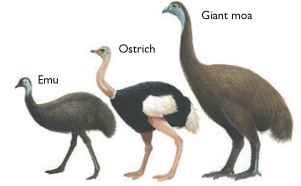
VITAL |
|
| STATISTICS | |
| Weight | Female about 249 lbs.; male up to 339 lbs. |
| Height | 6-8′ |
| Sexual Maturity | Female 2 years; male 3-4 years |
| Mating season | Variable, often dependent on local climatic conditions |
| Number of Eggs | Each female 1 ays 5-11 eggs |
| Incubation Period | 42-46 days |
| Breeding Interval | Unknown |
| Typical Diet | Mostly plant material; some invertebrates |
| Lifespan | Up to 40 years |
RELATED SPECIES
• The ostrich is the only member of the family Struthionidae. Other flightless birds around the world are the rheas of South America, the kiwis of New Zealand and the cassowaries (below) and emus of Australia.
